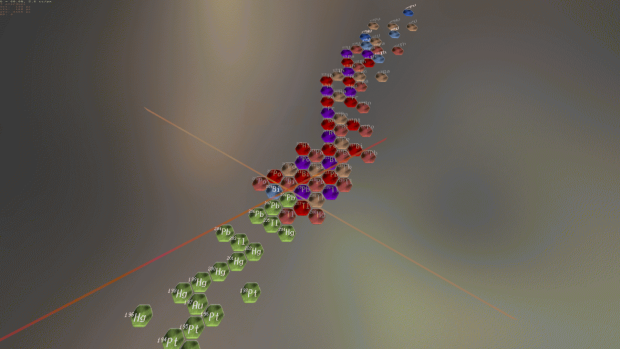Brahma is a 3D game engine with a rather retrofuturistic design, intended for small studios and solo developers. It's being written from scratch in C++ using standard Windows API and no third-party libraries. This technology introduces an entirely new class of low-latency real-time engines that make special timing requirements, treating frames as video fields with a target time budget of 2-4 ms each, down from 16-33 ms frame budgets normally seen in game engines. It evolves in a different way than other modern engines, rejecting conventional BSP, Z-buffer, floating-point coordinates, and most of the lame screen-space effects in favor of innovative and efficient techniques. The engine is non-Euclidean capable to some degree; also it supports true displacement mapping for sectors as a means to virtualize geometry that affects collisions. The engine is also carefully designed to be easy and convenient to develop for, yet versatile and adaptive to any needs.
Aside from the periodic table, the engine can also offer great ways to teach nuclear physics. For example, here I made a table of primordial nuclides that you can fly around. I'm going to include this and other sample maps in the test release.
The vertical axis corresponds to the atomic mass number (i.e. the sum of proton and neutron counts), while horizontally there is surplus of neutrons over protons. This naturally yields a hexagonal layout that is informative and convenient: alpha decay goes straight downward, and beta decay goes roughly the same distance to the left. The normally presented rectangular table is less intuitive and also requires one to split the table into pieces or scroll both vertically and horizontally.
The nuclides are color-coded to differentiate stable nuclides from primordial nuclides that are very slightly radioactive. There are also decay chains shown at the top of the table.
Usage of billboard sprites for atomic symbols and masses is convenient when you view the table from various angles, because the text is always readable.







"the engine can also offer great ways to teach nuclear physics"
wow, this is one hell of a game engine. Although I do wonder if
functions like these will ever be used.
Maybe a stupid question, because I asked this already years ago, but how far
are you with the engine qua game development? Is it near completion to build
an fps game on?
greetings, a fan of your work,
Leon
It depends on how complex you want your FPS game to be. It's not really far from building an oldschool Doom clone using the engine, with some eye-candy brought in. For this, I still have to put more work into the tools like the level editor. I can't go any faster since I can't currently work on it full-time, but there are some groundbreaking innovations on the way that I should prioritize to make it possible to build an actual game.
The version I'm aiming to release sometime in 2023 will be a game construction kit consisting of some prefabricated effects and tools to modify assets and alter the default behavior. In short, it would be a small tech demo that can be modded and extended with ease (and with no coding).
Oke, that really does sound awesome. And somewhere in 2023 is great because I am still working on a large mod, but that will be released around the summer. And then I will be looking into indie development finally. I am following your work as always so I will be back for sure around then at least. Exciting times!
Leon
Will be possible to have some simple enemies and weapons for gameplay testing in the new version? And with a Doom clone do you also mean a Duke 3D clone or would that require more time? Sounds exciting anyway, especially for the "no coding" part, because I've always been very slow writing code.
I'll see what I can do on that part. There were some weapons prototyped a couple of years ago just for testing the projectiles, I'll just have to troubleshoot the projectile physics to make it to the test version. As for the enemies, I was going to code in some pathfinding system so they could navigate from one area to another.